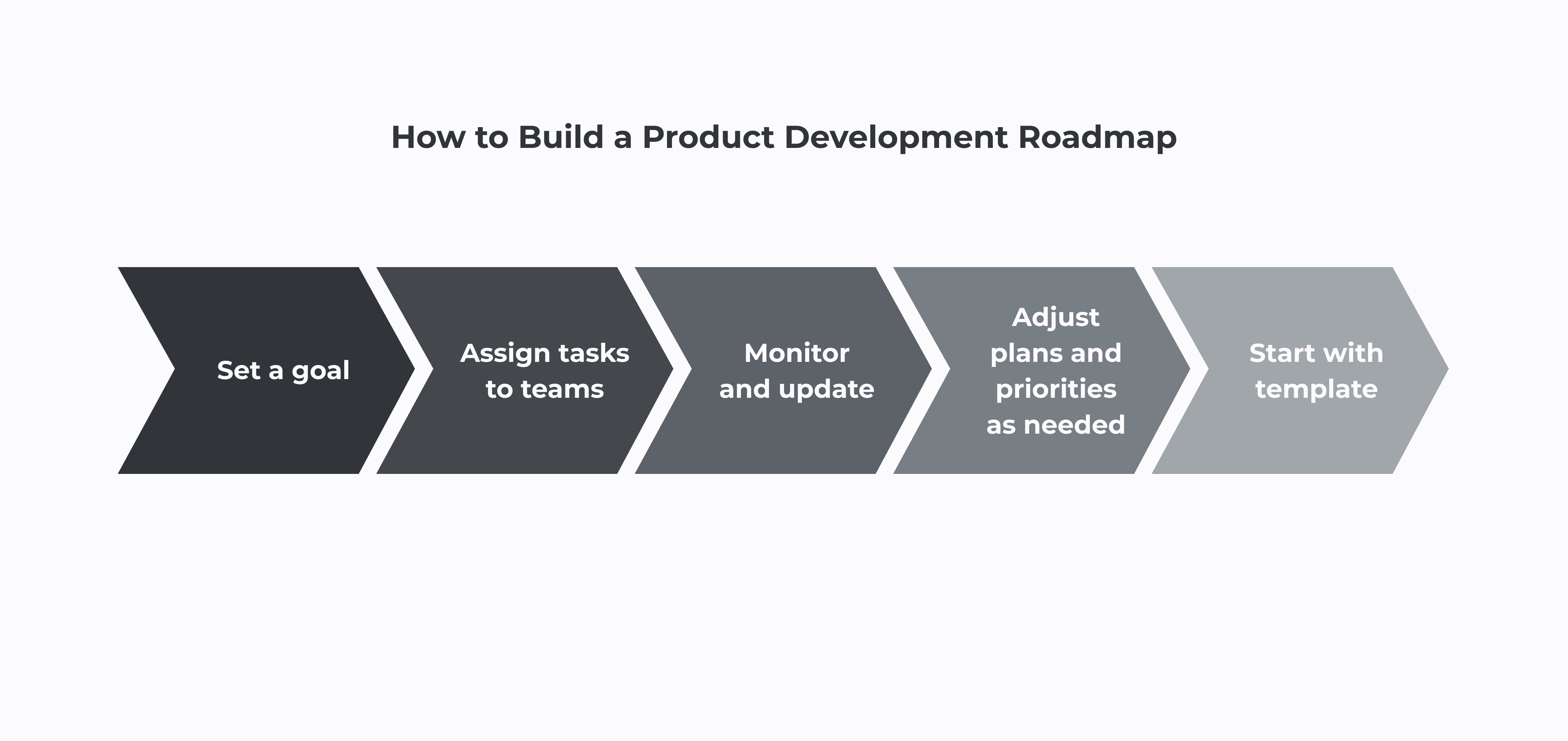Product Development Roadmap: Key Features and Examples

Developing a successful product is a very complex process that is full of pitfalls. It all starts with a decent idea that is based on an in-depth analysis of the market and the needs of the audience. However, according to data from the McKinsey Global Institute, for every 7 product ideas, only 1.5 launch, and only 1 succeeds. So the idea is only the beginning of the journey, the most important thing is the implementation of the project. Without proper team synchronization and planning, development is stretched over a long time, and not all initial requirements are met. To prevent problems in product development and increase the chances of success, it is critical to use a strategic document - a product development roadmap. In this article, we’ll explain what a roadmap is, why it’s critical for a product, describe the algorithm for creating a roadmap, and provide an example you can use to create a viable and profitable product.
What Is a Product Development Roadmap?
The product development roadmap is the product vision and the only reliable source of information. A product development roadmap is a strategic and high-level plan of actions that outlines the vision, milestones, and initiatives of a product binding them with a company’s business goals. During development, the product development roadmap serves as the main context for the team’s daily work, and it is modified based on progress and changes made.
Why is a Product Development Roadmap Important?
The product development roadmap includes development steps and various groups’ roles so that every team member can refer to their strategic role, consider the milestones, and track their progress to make sure they perform their tasks according to plan. Utilizing a product development roadmap has the following benefits.
- You speed up your time to market.
- You have a clearly defined strategy you work towards.
- You keep all team members motivated.
- You have an opportunity to plan and prioritize tasks, keep track of dev teams, and update other departments on time.
- All stakeholders see the transparency of all decisions.
- It helps to decide on the success metrics and make incremental improvements.
- The roadmap offers updates from a development team in an easy-to-understand way.
Types of Product Development Roadmaps
Roadmaps can be divided into external and internal. Internal roadmaps for the development team contain information about the priority customer value, the main stages of development (sprints), plotted on a timeline. Internal roadmaps for executives are often not very detailed and provide information about the team’s progress toward achieving the main goals. External roadmaps are designed to generate customer interest. These maps should give an idea of the main functions of the product and the direction of its development.
So, as you can see, there are many product development roadmaps. Below, we will describe the main ones.
Software Roadmap

This roadmap is useful for those who create a project from scratch. The whole process is divided into two stages: development and marketing. Each stage is clearly structured and has its deadlines. This roadmap allows you to coordinate all tasks and processes efficiently and clearly.
Multiple Product Roadmap

This roadmap is great for the release of multiple products. You have several product lines and can track all processes and their status: planned, approved, in development, or completed. Therefore, you can effectively control all processes and coordinate your actions depending on your progress.
Objectives & Key Results (OKRs) Roadmap

Objectives and Key Results (OKRs) is a useful framework for setting goals and KPIs for both the broader organization and specific teams within it. This roadmap allows your team to focus on working on the paramount tasks.
Executive-Facing Portfolio Roadmap

An executive-facing portfolio roadmap is a visualization of the product strategy and its implementation schedule. All the plans are connected in a single set, which makes it easier for managers to analyze and check products against business objectives.
How to Build a Product Development Roadmap?

Here are the stages you should follow to build a product development roadmap.
1. Set a clear objective
A roadmap is more than just a list of tasks. The roadmap should unite all tasks with a single goal: to achieve product success. So, first, establish a strategy for your product. To do this, adhere to the following rules:
-
Define the pain(s) your product solves
The key here is to determine solutions to challenges your audience has. Remember that your product should be either exceptional or a killer app that will outperform its competitors.
-
Analyze the market
Conduct competitive research, find out what makes your competitors unique, and what their value proposition is.
-
Identify your target audience
Build a profile of your ideal customer to find out who and why will use your product. Thus, all elements should contribute to the strategic achievement of your goal.
2. Assign tasks to certain specialists/groups
For development to be effective, make sure that every task is assigned to a specialist responsible for ensuring that it is completed within the agreed time frame.
3. Keep track of the roadmap regularly and update it as needed
Monitor and update your roadmap as needed. Development is a dynamic process, and milestones and tasks can change. Be sure to keep the cross-functional team dependencies (UX and development) up to date with any necessary changes. To do this, make sure the task board is displayed on the dashboard of all team members.
4. Reprioritize your goals according to new realities
The most successful roadmaps are those that take into account the latest changes. Priorities and resources may alter, so the roadmap is also a dynamic plan. Be sure to prioritize the tasks by importance, and constantly monitor the development process. Be prepared to reprioritize goals and reallocate resources.
Product Development Roadmap Template
There are many templates you can utilize based on your business goals. Here is one of the examples you can use and modify if necessary.

Bottom Line
We hope this guide will help you better understand what a product development roadmap looks like and how to develop an effective strategy to get to the top. You can use a specific template and edit it to suit your objectives. If you are looking for a company to create a first-class product for you, Yojji specialists have the knowledge and skills you need. Contact us for more information.

Yojji successfully delivered the project within schedule. They demonstrated excellent project management via weekly sprint demos and promptly made adjustments based on the client's feedback. Their responsiveness and collaborative attitude were key elements of their work.

5.0
Yojji was an instrumental part of the client’s team, working closely with them to achieve the product’s success. The team was very collaborative and timely, and their performance was amazing. Additionally, their resources were experienced, professional, and enjoyable to work with.

5.0
Yojii is impressive both in quality of development work as well as their commitment. Strong focus on delivery, highly technical personnel, flexible approach that allows for rapid development. Strong processes that allow for solid controls.

5.0
We’re very happy with the way that Yojji works, which is why we’ve spent so much money and engaged them for such a long time. We treat them as employees in regard to responsibilities and expectations, and they haven’t disappointed us.

5.0
As a company, we find Yojji to be excellent development partners - we cannot recommend them more highly and will be very happy to continue working with them in the future.

5.0
They are really nice people with excellent technical backgrounds.

5.0
We used Agile project management methodology and were in contact with the team and project manager daily.

5.0
They all had a super positive outlook and were dedicated to getting the work completed to a high standard.

5.0
Yojji has delivered an accessible product with thorough consideration for the client's requirements. Users have commented on the platform's user-friendliness and speed. Moreover, the team is easy to communicate with and provides frequent updates. Their development and design skills are impressive.

5.0





